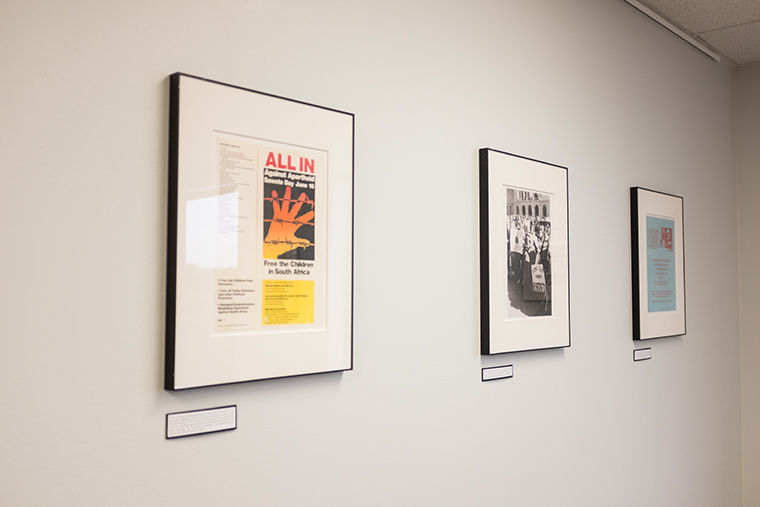Library hosts exhibit on battle against apartheid
October 16, 2017

A new exhibit in the library called Chicago Against Apartheid. The exhibit shows the history of Chicago activists fighting against the Apartheid. Photo taken on Oct. 12.
An exhibit hosted by the Columbia Library titled “Chicago Against Apartheid” showcases college archive collections of social organizations fighting against the South African apartheid regime from the 1970s–1990s.
The National Party was an all-white government in South Africa that came into power in 1948 and enforced extreme racial segregation under a system of legislation called apartheid. Under this, people of color were not allowed to vote and were forced into horrible living situations, according to Kelsey O’Connell, associate archivist in the Library.
The exhibit is located on the Library’s fifth floor, 624 S. Michigan Ave., and will run throughout the fall semester. Students will be able to look at photographs and posters of Chicago protesters of South African apartheid.
O’Connell curated the exhibit to coincide with the African Studies Association Conference—the largest conference for people who teach African studies—that will be held in Chicago in November, according to Heidi Marshall, head of College Archives and Special Collections.
O’Connell said Chicago’s anti-apartheid movement was connected to Columbia during that time because several faculty members joined organizations to oppose apartheid.
“We curated the exhibit to highlight several Chicagoans working to help end this political system,” O’Connell said. “A couple of them have taught at the college or worked at the college.”
Prexy Nesbitt, adjunct professor in the Humanities, History and Social Sciences Department, said he participated in several organizations nationwide such as Coalition for Illinois’ Divestment from South Africa. Some of his work is archived in the collection.
Nesbitt said he illegally crossed into South Africa twice to fight against the government because it was illegal to enter the country during the regime.
“We were taking in mattresses filled up with propaganda against the apartheid regime, leaflets and flyers,” Nesbitt said. “I then went in once illegally via another country and had to come out dressed as a nun so as to avoid capture.”
O’Connell said it is important for students to understand this part of history so they can learn from the past and prevent similar problems in the future.
“Columbia students will be able to understand the cultural significance and understand that our actions every day play a part in our cultural memory and our history,” O’Connell said. “What choices we make now may impact our future.”
Nesbitt said the collection is also an excellent way to teach students about current activist movements, such as Black Lives Matter and the NFL protests.
“[Modern protests] didn’t come out of nowhere, they come because they’re connected to the struggles and engagement people have had in the past,” Nesbitt said. “This exhibit helps us learn about that engagement, particularly about the need we have to deal with race in this country.”
This exhibit is also meant to show students the various resources and materials available to help them with their studies, O’Connell said.
“There aren’t a lot of people at the school who know we have this collection and what’s important is to get it to [students],” Marshall said, “to the next generation of people that need to know about this. It is a collection that really helps take a look at what a protest looks like before the internet.”







